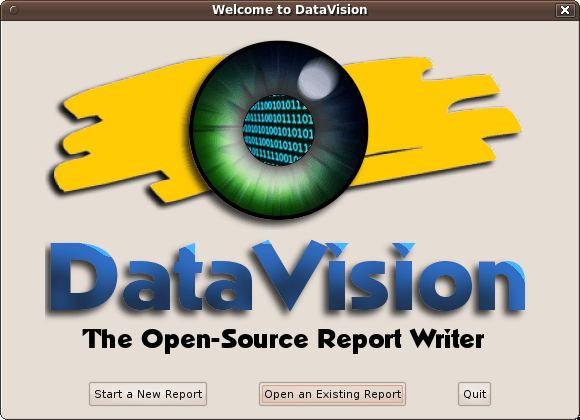Last Updated on November 13, 2022
DataVision is an Open Source database reporting tool similar to Crystal Reports.
Reports can be designed using a drag-and-drop GUI. They may be run, viewed, and printed from the application or exported as HTML, XML, PDF, LaTeX2e, DocBook, or tab- or comma-delimited text files.
The output files produced by LaTeX2e and DocBook can, in turn, be used to produce PDF, text, HTML, PostScript, and more.
DataVision is written in Java. It can generate reports from databases or text data files. Any database that has a JDBC driver will work. This includes Oracle, PostgreSQL, MySQL, Informix, HSQLDB, and others. Columns read from text files can be separated by any character.
Report descriptions are stored as XML files. This means users can not only use the DataVision GUI but may also edit reports using a favorite text editor.
Features include:
- Drag-and-drop report builder.
- Report headers and footers, page headers and footers, group headers and footers.
- Report field formatting: color, numeric and date format, italic, bold, border lines, etc.
- Editable report-wide default field format.
- Sub-reports.
- Visual table linker.
- Aggregates (sum, min, max, count, average, stddev) by group and at report’s end.
- Record sorting.
- Sub-selects allowed within SQL WHERE clauses.
- Formulas, using any language supported by the Bean Scripting Framework (BSF). The default formula language shipped with DataVision is Ruby (via JRuby).
- Record selection (SQL WHERE clause for database data sources, BSF script that accepts/rejects records for character-separated file data sources).
- Run-time parameters; asks the user for values when the report runs; if running from the command line, reads values in from an XML file.
- Run-time variables (again thanks to the BSF). A script run at the start of each report run is the perfect place to set all your initial values.
- User-defined SELECT clause columns; useful for calling stored procedures or SQL functions.
- Hide columns and entire sections.
- Reports can read data from different data sources. Currently, data sources are defined for databases and text data files (comma-separated, tab-separated, etc).
- When reading text data files, translates date and numeric columns into the appropriate Java classes so they can be manipulated as such (formatted, used in formulas, etc).
- Run and view reports on-screen.
- Print report from DataVision.
- Exports to HTML, XML, PDF, comma-separated, tab-separated, DocBook, LaTeX.
- GUI translated into eleven languages.
- Report definitions stored as human-readable XML.
- Embeddable within your own application.
Website: datavision.sourceforge.net
Support: User’s Manual
Developer: Frank W. Zammetti, Jim Menard
License: Apache Software License v 2.0

DataVision is written in Java. Learn Java with our recommended free books and free tutorials.
Return to Business Intelligence Software Home Page
| Popular series | |
|---|---|
| The largest compilation of the best free and open source software in the universe. Each article is supplied with a legendary ratings chart helping you to make informed decisions. | |
| Hundreds of in-depth reviews offering our unbiased and expert opinion on software. We offer helpful and impartial information. | |
| The Big List of Active Linux Distros is a large compilation of actively developed Linux distributions. | |
| Replace proprietary software with open source alternatives: Google, Microsoft, Apple, Adobe, IBM, Autodesk, Oracle, Atlassian, Corel, Cisco, Intuit, and SAS. | |
| Awesome Free Linux Games Tools showcases a series of tools that making gaming on Linux a more pleasurable experience. This is a new series. | |
| Machine Learning explores practical applications of machine learning and deep learning from a Linux perspective. We've written reviews of more than 40 self-hosted apps. All are free and open source. | |
| New to Linux? Read our Linux for Starters series. We start right at the basics and teach you everything you need to know to get started with Linux. | |
| Alternatives to popular CLI tools showcases essential tools that are modern replacements for core Linux utilities. | |
| Essential Linux system tools focuses on small, indispensable utilities, useful for system administrators as well as regular users. | |
| Linux utilities to maximise your productivity. Small, indispensable tools, useful for anyone running a Linux machine. | |
| Surveys popular streaming services from a Linux perspective: Amazon Music Unlimited, Myuzi, Spotify, Deezer, Tidal. | |
| Saving Money with Linux looks at how you can reduce your energy bills running Linux. | |
| Home computers became commonplace in the 1980s. Emulate home computers including the Commodore 64, Amiga, Atari ST, ZX81, Amstrad CPC, and ZX Spectrum. | |
| Now and Then examines how promising open source software fared over the years. It can be a bumpy ride. | |
| Linux at Home looks at a range of home activities where Linux can play its part, making the most of our time at home, keeping active and engaged. | |
| Linux Candy reveals the lighter side of Linux. Have some fun and escape from the daily drudgery. | |
| Getting Started with Docker helps you master Docker, a set of platform as a service products that delivers software in packages called containers. | |
| Best Free Android Apps. We showcase free Android apps that are definitely worth downloading. There's a strict eligibility criteria for inclusion in this series. | |
| These best free books accelerate your learning of every programming language. Learn a new language today! | |
| These free tutorials offer the perfect tonic to our free programming books series. | |
| Linux Around The World showcases usergroups that are relevant to Linux enthusiasts. Great ways to meet up with fellow enthusiasts. | |
| Stars and Stripes is an occasional series looking at the impact of Linux in the USA. | |